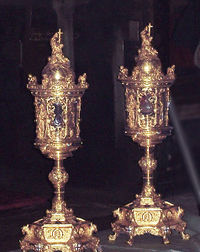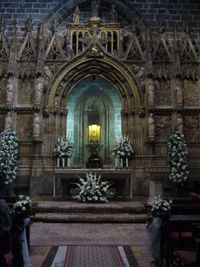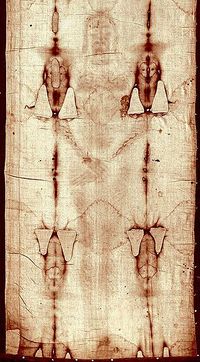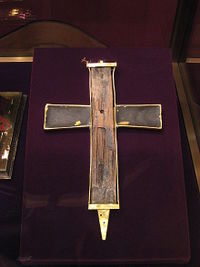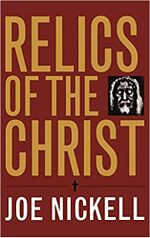Difference between revisions of "Category:Relics of Jesus (subject)"
| (19 intermediate revisions by the same user not shown) | |||
| Line 1: | Line 1: | ||
*[[:Category:Artifacts|BACK | [[File:Holy Blood Mantua.jpg|thumb|200px|Relic of the Holy Blood (Mantua, Italy)]] | ||
[[File:Grail Valencia.jpg|thumb|200px|Relic of the Holy Grail (Valencia, Spain)]] | |||
[[File:Shroud Turin.jpg|thumb|200px|The Shroud (Turin, Italy)]] | |||
[[File:True Cross Vienna.jpg|thumb|200px|Fragment of the Holy Cross (Vienna, Austria)]] | |||
*[[:Category:Artifacts|BACK to the ARTIFACTS--INDEX]] | |||
*[[Jesus|BACK to the JESUS--INDEX]] | |||
'''Relics of Jesus''' refers to a series of artifacts (mostly of medieval origin) which were believed to be connected with the historical Jesus. | '''Relics of Jesus''' refers to a series of artifacts (mostly of medieval origin) which were believed to be connected with the historical Jesus. | ||
< ''[[Life of Jesus]]'' : [[Nativity of Jesus]] -- [[Childhood of Jesus]] -- [[Jesus' Hidden Years]] -- [[Ministry of Jesus]] ([[Parables of Jesus]], [[Miracles of Jesus]]) -- [[Passion of Jesus]] -- [[Resurrection of Jesus]] -- [[Relics of Jesus]] > | |||
* This page was created and is edited by [[Gabriele Boccaccini]], University of Michigan | * This page was created and is edited by [[Gabriele Boccaccini]], University of Michigan | ||
| Line 21: | Line 29: | ||
While scholars dismiss the authenticity of all these ancient relics, the interest in Jesus' relics has lately increased in fictional and arch-fi circles, which speculate especially on the possibility of extracting Jesus' DNA for cloning; see [[Jesus Cloning]]. | While scholars dismiss the authenticity of all these ancient relics, the interest in Jesus' relics has lately increased in fictional and arch-fi circles, which speculate especially on the possibility of extracting Jesus' DNA for cloning; see [[Jesus Cloning]]. | ||
== | ==List of major Relics associated with Jesus== | ||
====Nativity of Jesus==== | |||
* [[Gifts of the Magi]], and [[Tombs of the Magi]] | |||
* [[Holy Prepuce]] | * [[Holy Prepuce]] | ||
== | ====Preaching of Jesus==== | ||
* [[ | * [[Mount of the Beatitudes]] | ||
* [[Mensa Christi]] ('"Table of Jesus'') | |||
====Last Supper==== | |||
* [[Holy Grail]] | * [[Holy Grail]] | ||
====Arrest and Trial of Jesus==== | |||
* [[Holy Prison]] (Prison of Jesus) | |||
* [[Column of the Flagellation]] | * [[Column of the Flagellation]] | ||
| Line 39: | Line 57: | ||
* [[Crown of Thorns]] | * [[Crown of Thorns]] | ||
====Crucifixion, Burial, and Resurrection of Jesus==== | |||
* [[Via Dolorosa]] | |||
* [[Veil of Veronica]] | * [[Veil of Veronica]] | ||
* [[Holy Robe]] | * [[Holy Robe]] | ||
* [[True Cross]], [[Holy Nails]], and [[Titulus Crucis]] | |||
* [[Holy Sponge]] | |||
* [[Holy Lance]] | * [[Holy Lance]] | ||
* [[Holy Blood]] | * [[Holy Blood]] | ||
* [[Stone of Anointing]] | |||
* [[Tomb of Jesus]] | |||
* [[Shroud of Turin]] | * [[Shroud of Turin]] | ||
* [[Shroud of Oviedo]] | * [[Shroud of Oviedo]] | ||
== [[Relics of the Christ (2007 Nickell), book]] == | |||
[[File:2007 Nickell.jpg|thumb|left|150px]] | |||
"The Holy Grail, the Lance of Longinus, and the True Cross are some of the most revered artifacts in the world today. These Christian relics are also a source of limitless controversy. They have incited bloodshed and, some say, are a source of miracles. They inspire fear and hope among the faithful, and yet are a perennial target for skeptics, both Christian and secular. To research the authenticity of numerous Christian relics, Joe Nickell employs a scientific approach, using such techniques as radiocarbon dating, polarized-light microscopy, and forensic serology. Examined here are such significant relics as the Shroud of Turin, the multiple heads of John the Baptist, and the "incorruptible" corpses of saints. For each relic, Nickell examines evidence indicating that the item is legitimate, evidence suggesting that it is not, and whether or not the relic and the miracles attributed to it can be recreated. In addition to his own experiments, Nickell presents findings from the world's top scientists and historians regarding these controversial objects of reverence and ire. But he is ultimately guided by the maxim, "extraordinary claims require extraordinary proof." In treating each relic as a mystery to be solved, Nickell seeks only to find the truth."--Publisher description | |||
=== Contents === | |||
Introduction : the life of Jesus -- The cult of relics -- Christian relics -- The Holy Grail -- Self-portraits of Jesus -- The true Cross -- Other crucifixion relics -- Holy shrouds -- The Shroud of Turin -- 'Photograph' of Christ -- The Sudarium of Oviedo -- Blood of Jesus -- The James ossuary. | |||
==External links== | ==External links== | ||
Latest revision as of 08:10, 21 December 2021
Relics of Jesus refers to a series of artifacts (mostly of medieval origin) which were believed to be connected with the historical Jesus.
< Life of Jesus : Nativity of Jesus -- Childhood of Jesus -- Jesus' Hidden Years -- Ministry of Jesus (Parables of Jesus, Miracles of Jesus) -- Passion of Jesus -- Resurrection of Jesus -- Relics of Jesus >
- This page was created and is edited by Gabriele Boccaccini, University of Michigan
Overview
It was common practice in the ancient Church to preserve and venerate relics of Christian saints and martyrs.
Christian teaching states that Jesus was assumed into heaven corporeally. Therefore the only relics that could be collected were either objects belonging to, or touch by, Jesus, or parts of his body he had lost prior to his resurrection-—hair, blood, fingernails, milk teeth, his prepuce (from his circumcision), and the umbilicus (from his birth).
Reliquaries containing bodily parts of Jesus could actually be commonly found in Europe during the Middle Ages. As an example, at that time there were as many as 18 churches claiming possession of the Holy Prepuce of Jesus: in Italy, France, Germany, Belgium, etc.
Most of those relics were lost or destroyed during the Reformation or the French Revolution. The authorities of the Catholic Church also began looking with great skepticism to those relics, as all of them were of very dubious provenance (to say the least). The cult of bodily parts of Jesus was discouraged and gradually felt into oblivion.
According to the Catholic Encyclopedia, "Very little reliance can be placed upon the authenticity of these specimens.” There is neither reliable, conclusive evidence nor historical record supporting the identification of these relics as genuine. On the contrary, all evidence leads to the conclusion that the search and collection of relics of Jesus started not before the fourth century CE and reached its climax during the Middle Age at the time of the Crusades.
While scholars dismiss the authenticity of all these ancient relics, the interest in Jesus' relics has lately increased in fictional and arch-fi circles, which speculate especially on the possibility of extracting Jesus' DNA for cloning; see Jesus Cloning.
List of major Relics associated with Jesus
Nativity of Jesus
Preaching of Jesus
- Mensa Christi ('"Table of Jesus)
Last Supper
Arrest and Trial of Jesus
- Holy Prison (Prison of Jesus)
A column, preserved at the Church of Santa Prassede in Rome, is only one of the many columns that are said to be the Column of the Flagellation.
Crucifixion, Burial, and Resurrection of Jesus
Relics of the Christ (2007 Nickell), book
"The Holy Grail, the Lance of Longinus, and the True Cross are some of the most revered artifacts in the world today. These Christian relics are also a source of limitless controversy. They have incited bloodshed and, some say, are a source of miracles. They inspire fear and hope among the faithful, and yet are a perennial target for skeptics, both Christian and secular. To research the authenticity of numerous Christian relics, Joe Nickell employs a scientific approach, using such techniques as radiocarbon dating, polarized-light microscopy, and forensic serology. Examined here are such significant relics as the Shroud of Turin, the multiple heads of John the Baptist, and the "incorruptible" corpses of saints. For each relic, Nickell examines evidence indicating that the item is legitimate, evidence suggesting that it is not, and whether or not the relic and the miracles attributed to it can be recreated. In addition to his own experiments, Nickell presents findings from the world's top scientists and historians regarding these controversial objects of reverence and ire. But he is ultimately guided by the maxim, "extraordinary claims require extraordinary proof." In treating each relic as a mystery to be solved, Nickell seeks only to find the truth."--Publisher description
Contents
Introduction : the life of Jesus -- The cult of relics -- Christian relics -- The Holy Grail -- Self-portraits of Jesus -- The true Cross -- Other crucifixion relics -- Holy shrouds -- The Shroud of Turin -- 'Photograph' of Christ -- The Sudarium of Oviedo -- Blood of Jesus -- The James ossuary.
External links
Pages in category "Relics of Jesus (subject)"
This category contains only the following page.
Media in category "Relics of Jesus (subject)"
This category contains only the following file.
- 2007 Nickell.jpg 314 × 499; 24 KB
